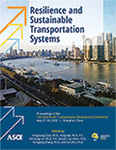13th Asia Pacific Transportation Development Conference
Determining the Influence of Auto-Driving on Urban Road Traffic Conditions
Publication: Resilience and Sustainable Transportation Systems
ABSTRACT
With the rapid development of big data and artificial intelligence technology, autonomous driving has increasingly become a research hotspot in the field of transportation. Based on the basic meaning and development status of the overall automatic driving, the requirements of urban driving infrastructure for different levels of automatic driving are analyzed. From the theoretical level, the influence of autonomous driving on road capacity is analyzed. Two road networks are constructed by TransModeler simulation software. The effects of different levels of autonomous driving on road capacity and intersection delay were evaluated. In order to control other variables, only the one-way street is used to simulate the autopilot capacity, while the traffic delay is simulated by a single intersection. The study found that in a one-way two-lane environment, the traffic capacity under automatic driving conditions is about 63.74% higher than that of manned driving, but there is no significant difference between different levels of autonomous driving capacity; in the intersection environment, it is indicated automated driving can reduce the average delay of the intersection by 1%, but there is little difference between different levels of autonomous driving. The research results show that in the L4 level automatic driving environment, high-adaptive traffic signal control system, Beidou/GPS system ground enhancement station, high-precision positioning, roadside alarm unit, and other facilities should be constructed in the L5-level automatic driving environment. The networked vehicle system based on 5G technology and the implementation of the vehicle basic data interaction platform and artificial intelligence should be upgraded. Under the conditions of automatic driving, the road capacity is significantly improved, and the delay of the intersection is significantly reduced, indicating that the automatic driving has a good improvement effect on the road traffic operation state.
Get full access to this article
View all available purchase options and get full access to this chapter.
REFERENCES
Bose, A., and Ioannou, P. (1998). “Issues and analysis of mixed semi-automated/manual traffic.” SAE Technical Paper.
Ioannou, P. (1998). “Evaluation of mixed automated/manual traffic.” California Partners for Advanced Transit and Highways (PATH).
Huang, S., Ren, W., and Chan, S. C. (2000). “Design and performance evaluation of mixed manual and automated control traffic.” IEEE Transactions on Systems, Man, and Cybernetics-Part A: Systems and Humans, 30(6), 661-673.
Bose, A., and Ioannou, P. (2003a). “Analysis of traffic flow with mixed manual and semiautomated vehicles.” IEEE Transactions on Intelligent Transportation Systems, 4(4), 173-188.
Bose, A., and Ioannou, P. (2003b). “Mixed manual/semi-automated traffic: a macroscopic analysis.” Transportation Research Part C: Emerging Technologies, 11(6), 439-462.
Jiang, R., and Wu, Q. S. (2006). “The adaptive cruise control vehicles in the cellular automata model.” Physics Letters A, 359(2), 99-102.
Jiang, R., and Wu, Q. S. (2005). “First order phase transition from free flow to synchronized flow in a cellular automata model.” The European Physical Journal B-Condensed Matter and Complex Systems, 46(4), 581-584.
Chen, S., Kong, L., Zheng, R., Kong, L., and Liu, M. (2009). “Investigation on mixed traffic system with automatic cruise control.” ACTA Physica Sinica, 58(4), 2271-2275.
Yuan, Y. M., Jiang, R., Hu, M. B., Wu, Q. S., and Wang, R. (2009). Traffic flow characteristics in a mixed traffic system consisting of ACC vehicles and manual vehicles: A hybrid modelling approach. Physical A: Statistical Mechanics and its Applications, 388(12), 2483-2491.
Chen, S. D., Kong, L. J., Liu, M. R., Zheng, R. S., and Zhu, L. H. (2009). “Investigation on mixed traffic system with automatic cruise control.” Acta Physica Sinica, (4), 2271-2275.
Ward, J. A. (2009). Heterogeneity, lane-changing and instability in traffic: A mathematical approach (Doctoral dissertation, University of Bristol).
Varotto, S. F., Hoogendoorn, R. G., van Arem, B., and Hoogendoorn, S. P. (2015). “Empirical longitudinal driving behavior in authority transitions between adaptive cruise control and manual driving.” Transportation Research Record, 2489(1), 105-114.
Talebpour, A., and Mahmassani, H. S. (2016). “Influence of connected and autonomous vehicles on traffic flow stability and throughput.” Transportation Research Part C: Emerging Technologies, 71, 143-163.
Mahmassani, H. S. (2016). “50th anniversary invited article—autonomous vehicles and connected vehicle systems: flow and operations considerations.” Transportation Science, 50(4), 1140-1162.
Ma, X., Hu, Y., and Yang, Q. (2018). “Modeling and Simulation for the Traffic Flow of Mixed Driving of Ordinary Vehicles and Automatic Driving Trucks on Double Lanes.” Journal of Transportation Systems Engineering and Information Technology, 18(6), 72-80.
Qin, Y. (2018). “Impact Analysis of Traffic Emissions of Autonomous Vehicles at Highway On-ramp.” Journal of xuzhou Institute of Technology (Natural Sciences Edition), (3), 83-87.
Song, H., and Wu, D. (2018). “Research about Traffic Simulation Based on Connected Vehicles and Autonomous Vehicles.” Logistics Engineering and Management, (9), 57-59.
Qin, Y., Wang, H., and Ran, B. (2019). “Impact of Connected and Automated Vehicles on Passenger Comfort of Traffic Flow with Vehicle-to-vehicle Communications.” KSCE Journal of Civil Engineering, 23(2), 821-832.
Di, X., Zhao, Y., Huang, S., and Liu, H. X. (2018). “A Similitude Theory for Modeling Traffic Flow Dynamics.” IEEE Transactions on Intelligent Transportation Systems, 20(3), 900-911.
Lee, S., Jeong, E., Oh, M., and Oh, C. (2019). “Driving aggressiveness management policy to enhance the performance of mixed traffic conditions in automated driving environments.” Transportation research part A: policy and practice, 121, 136-146.
Information & Authors
Information
Published In
Resilience and Sustainable Transportation Systems
Pages: 734 - 745
Editors: Fengxiang Qiao, Ph.D., Texas Southern University, Yong Bai, Ph.D., Marquette University, Pei-Sung Lin, Ph.D., University of South Florida, Steven I Jy Chien, Ph.D., New Jersey Institute of Technology, Yongping Zhang, Ph.D., California State Polytechnic University, and Lin Zhu, Ph.D., Shanghai University of Engineering Science
ISBN (Online): 978-0-7844-8290-2
Copyright
© 2020 American Society of Civil Engineers.
History
Published online: Jun 29, 2020
Published in print: Jun 29, 2020
Authors
Metrics & Citations
Metrics
Citations
Download citation
If you have the appropriate software installed, you can download article citation data to the citation manager of your choice. Simply select your manager software from the list below and click Download.
